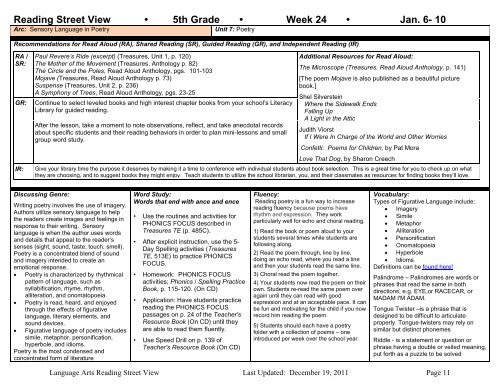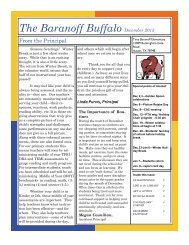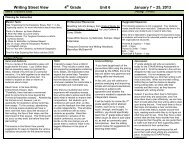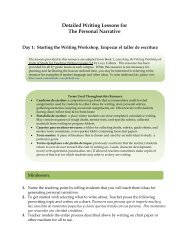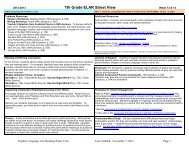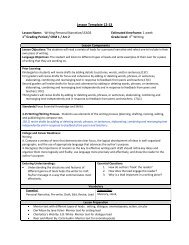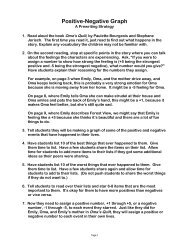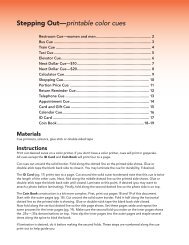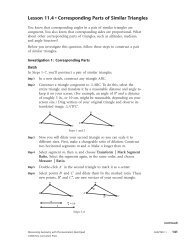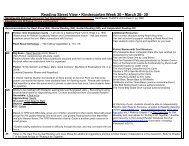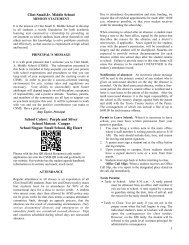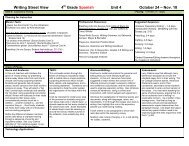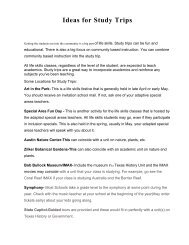Reading street view • 5th grade • week 19 • jan. 5-6
Reading street view • 5th grade • week 19 • jan. 5-6
Reading street view • 5th grade • week 19 • jan. 5-6
You also want an ePaper? Increase the reach of your titles
YUMPU automatically turns print PDFs into web optimized ePapers that Google loves.
<strong>Reading</strong> Street View • <strong>5th</strong> Grade • Week 24 • Jan. 6- 10Arc: Sensory Language in PoetryUnit 7: PoetryRecommendations for Read Aloud (RA), Shared <strong>Reading</strong> (SR), Guided <strong>Reading</strong> (GR), and Independent <strong>Reading</strong> (IR)RA /SR:GR:IR:Paul Revere’s Ride (excerpt) (Treasures, Unit 1, p. 120)The Mother of the Movement (Treasures, Anthology p. 82)The Circle and the Poles, Read Aloud Anthology, pgs. 101-103Mojave (Treasures, Read Aloud Anthology p. 73)Suspense (Treasures, Unit 2, p. 236)A Symphony of Trees, Read Aloud Anthology, pgs. 23-25Continue to select leveled books and high interest chapter books from your school’s LiteracyLibrary for guided reading.After the lesson, take a moment to note observations, reflect, and take anecdotal recordsabout specific students and their reading behaviors in order to plan mini-lessons and smallgroup word study.Additional Resources for Read Aloud:The Microscope (Treasures, Read Aloud Anthology, p. 141)[The poem Mojave is also published as a beautiful picturebook.]Shel SilversteinWhere the Sidewalk EndsFalling UpA Light in the AtticJudith ViorstIf I Were In Charge of the World and Other WorriesConfetti: Poems for Children, by Pat MoraLove That Dog, by Sharon CreechGive your library time the purpose it deserves by making it a time to conference with individual students about book selection. This is a great time for you to check up on whatthey are choosing, and to suggest books they might enjoy. Teach students to utilize the school librarian, you, and their classmates as resources for finding books they’ll love.Discussing Genre:Writing poetry involves the use of imagery.Authors utilize sensory language to helpthe readers create images and feelings inresponse to their writing. Sensorylanguage is when the author uses wordsand details that appeal to the reader’ssenses (sight, sound, taste, touch, smell).Poetry is a concentrated blend of soundand imagery intended to create anemotional response.• Poetry is characterized by rhythmicalpattern of language, such assyllabification, rhyme, rhythm,alliteration, and onomatopoeia.• Poetry is read, heard, and enjoyedthrough the effects of figurativelanguage, literary elements, andsound devices.• Figurative language of poetry includessimile, metaphor, personification,hyperbole, and idioms.Poetry is the most condensed andconcentrated form of literatureWord Study:Words that end with ance and ence• Use the routines and activities forPHONICS FOCUS described inTreasures TE (p. 485C).• After explicit instruction, use the 5-Day Spelling activities (TreasuresTE, 513E) to practice PHONICSFOCUS.• Homework: PHONICS FOCUSactivities; Phonics / Spelling PracticeBook, p. 115-120. (On CD)• Application: Have students practicereading the PHONICS FOCUSpassages on p. 24 of the Teacher'sResource Book (On CD) until theyare able to read them fluently.• Use Speed Drill on p. 139 ofTeacher's Resource Book (On CD)Fluency:<strong>Reading</strong> poetry is a fun way to increasereading fluency because poems haverhythm and expression. They workparticularly well for echo and choral reading.1) Read the book or poem aloud to yourstudents several times while students arefollowing along.2) Read the poem through, line by line,doing an echo read, where you read a lineand then your students read the same line.3) Choral read the poem together.4) Your students now read the poem on theirown. Students re-read the same poem overagain until they can read with goodexpression and at an acceptable pace. It canbe fun and motivating for the child if you nowrecord him reading the poem.5) Students should each have a poetryfolder with a collection of poems – oneintroduced per <strong>week</strong> over the school year.Vocabulary:Types of Figurative Language include:• Imagery• Simile• Metaphor• Alliteration• Personification• Onomatopoeia• Hyperbole• IdiomsDefinitions can be found here!Palindrome – Palindromes are words orphrases that read the same in bothdirections, e.g. EYE,or RACECAR, orMADAM I'M ADAM.Tongue Twister –is a phrase that isdesigned to be difficult to articulateproperly. Tongue-twisters may rely onsimilar but distinct phonemesRiddle - is a statement or question orphrase having a double or veiled meaning,put forth as a puzzle to be solvedLanguage Arts <strong>Reading</strong> Street View Last Updated: December <strong>19</strong>, 2011 Page 11


